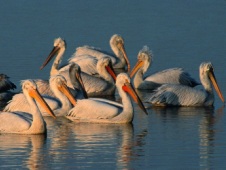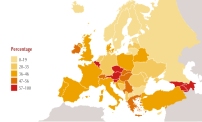
Almost one third of Europe’s Important Bird Areas are threatened by agricultural intensification and expansion. Wetland IBAs have suffered particularly badly, as water has been diverted for irrigation schemes.

In Europe, over the past three decades, the threats to Important Bird and Biodiversity Areas (IBAs) posed by agricultural intensification and expansion have been severe in some countries. For example, agricultural intensification and expansion threaten c.70% of IBAs in Austria and Belgium, and overall 32% of the c.4,500 IBAs in Europe (see figure a).
In Turkey, 50 out of 132 IBAs (c.38%) are significantly threatened by agricultural intensification and expansion (figure b; G. Eken in litt. 2003). Wetlands have suffered in particular: rivers, streams and lakes have been adversely affected by water-diversion schemes to feed intensively irrigated farms (Heath and Evans 2000). In addition, over the last century, at least 13,000 km2 of wetland habitat have been drained for conversion to arable land or otherwise destroyed, mainly since 1960. In the Konya basin of central Anatolia, two large wetlands (c.300 km2 in total) have recently dried up and three large wetland IBAs (Beysehir Lake, Sugla Lake and the Hotamis marshes) have sustained serious damage (G. Eken in litt. 2003). These sites are important for threatened and declining waterbirds, such as Dalmatian Pelican Pelecanus crispus (Vulnerable) and White-tailed Lapwing Vanellus leucurus.

Related Case Studies in other sections
Related Sites
Related Species
References
Compiled: 2004
Recommended Citation:
BirdLife International (2004)
Agricultural intensification threatens Important Bird Areas in Europe.
Downloaded from https://datazone.birdlife.org/sowb/casestudy/agricultural-intensification-threatens-important-bird-areas-in-europe on 22/12/2024